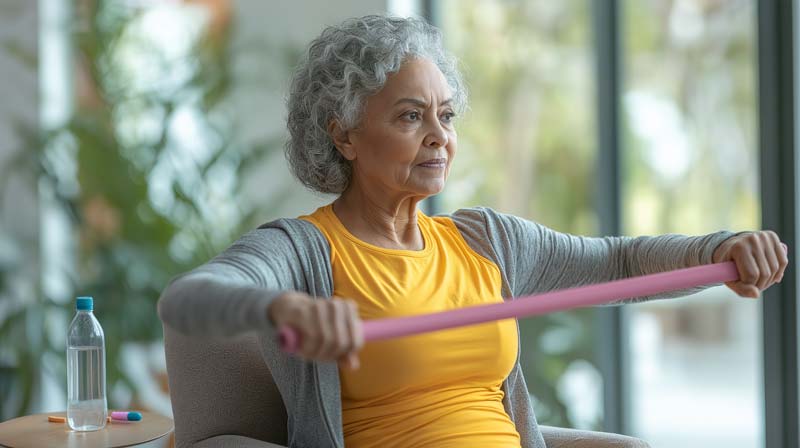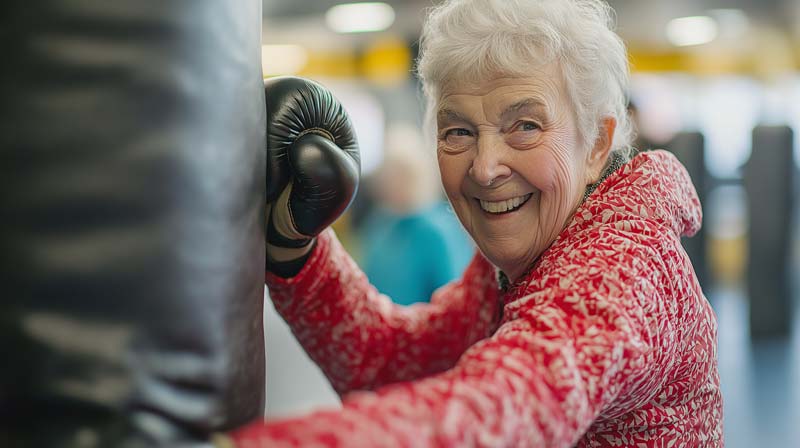By BeSund Editorial Team 11/07/2023 Modified Date: 11/10/2024
Parkinson's Disease
Discover the potential benefits of exercise for Parkinson's disease
Parkinson's Disease and Exercise Management

Understanding Parkinson’s Disease
Parkinson’s disease and exercise management represent a critical connection in modern healthcare. This progressive neurological disorder affects millions worldwide, with its impact including motor and non-motor symptoms. Recent research has illuminated the profound effects of physical activity on managing the condition’s diverse manifestations. Parkinson’s disease, characterised by the loss of dopamine-producing neurons in the brain, leads to a wide-ranging of symptoms that significantly impact quality of life. The World Health Organization reports that the global burden of Parkinson’s has doubled in the past 25 years, with over 8.5 million individuals affected as of 2019. As our understanding of Parkinson’s disease evolves, so does our management approach. While pharmaceutical interventions remain crucial, exercise has emerged as a powerful complementary strategy. From improving motor function to potentially slowing disease progression, physical activity offers multifaceted benefits for those living with Parkinson’s. The complexity of Parkinson’s disease necessitates a nuanced understanding of its mechanisms, symptoms, and management strategies.
Defining Parkinson’s Disease and Exercise Management
At its core, Parkinson’s is a progressive condition resulting from the loss of dopamine-producing neurons in a specific area of the brain called the substantia nigra pars compacta. This neuronal depletion leads to a number of motor and non-motor symptoms that profoundly affect daily functioning. Exercise management in Parkinson’s disease encompasses a range of physical activities designed to address the condition’s multifaceted challenges. These interventions alleviate motor symptoms and influence the disease’s trajectory. From aerobic exercises to resistance training, each modality offers unique benefits in managing Parkinson’s symptoms and enhancing overall wellbeing. Research continues to unveil the neuroprotective potential of physical activity in Parkinson’s disease and exercise management. This growing body of evidence suggests that exercise is not just a complementary therapy but a fundamental component of comprehensive care for individuals with Parkinson’s disease.
Symptoms and Progression
Parkinson’s disease manifests through a spectrum of symptoms that evolve over time. The hallmark motor symptoms include bradykinesia (slow movement), rigidity, tremor, and postural instability. These primary features can significantly impair mobility and daily activities, often leading to a decline in independence. The impact of Parkinson’s disease includes motor function, cognitive impairment, sleep disorders, depression, and autonomic dysfunction. These less visible manifestations can be equally debilitating and often precede the onset of motor symptoms by years. The progression of Parkinson’s disease varies among individuals but generally follows a gradual course. The Hoehn and Yahr scale, a system used to describe the progression of Parkinson’s disease symptoms, ranges from stages 1 to 5. Early stages may present with unilateral symptoms, while later stages can involve significant disability and potential cognitive decline. Defining Parkinson’s Disease and Exercise Management strategies play a crucial role throughout the disease course of Parkinson’s. Tailored physical activities can address specific symptoms, potentially influencing their progression and improving overall function. As the condition advances, exercise programs may need adaptation to accommodate changing abilities and needs.
Causes and Risk Factors
The aetiology of Parkinson’s disease involves genetic and environmental factors. While the exact cause remains elusive, research has identified several key contributors to the development of the condition. Genetic factors play a significant role in some cases of Parkinson’s disease, particularly in early-onset forms. Mutations in genes such as SNCA (which provides instructions for making alpha-synuclein), LRRK2 (leucine-rich repeat kinase 2), and PARK2 (parkin) have been associated with increased risk. However, genetic causes account for only a tiny percentage of cases, highlighting the importance of environmental influences. Environmental risk factors have garnered increasing attention in Parkinson’s disease research. Exposure to certain pesticides, herbicides, and industrial solvents has been linked to higher incidence rates. Additionally, factors such as head trauma, certain occupations, and even geographical location may influence disease risk. Age remains the most significant risk factor for Parkinson’s disease, with incidence rates rising sharply after 60 years. Interestingly, some lifestyle factors may modulate risk. Regular exercise and physical activity have been associated with lower rates of Parkinson’s disease, highlighting the potential protective effects of exercise management in this condition.
The Impact of Parkinson’s Disease and Exercise Management on Physical Performance
Parkinson’s disease and exercise management significantly influence physical performance in affected individuals. This progressive neurological disorder leads to a variety of motor and non-motor symptoms that profoundly affect daily functioning and quality of life.
- Motor symptoms include:
- Bradykinesia (slowness of movement)
- Rigidity
- Tremor
- Postural instability
- Non-motor symptoms encompass:
- Cognitive impairment
- Sleep disorders
- Depression
- Autonomic dysfunction
These symptoms collectively contribute to a decline in physical performance, impacting various aspects of an individual’s life. 
Motor Symptoms and Functional Limitations
The hallmark motor symptoms of Parkinson’s disease can substantially impair mobility and independence. Bradykinesia, characterised by slowness in initiating and executing movements, often manifests as reduced step length and slower walking speed. Combined with rigidity and tremor, this symptom can make simple daily tasks challenging. Even in the early stages of Parkinson’s disease, measurable disability is present relative to age-matched neurologically healthy controls:
- 25% of individuals with mild disease severity experience difficulty walking
- Those with de novo Parkinson’s disease have near-sedentary levels of physical activity, averaging only 5,362 (±2,890) steps per day.
- Patients with mild Parkinson’s disease (Hoehn and Yahr stage I) accumulate approximately 20% fewer steps per day than controls in a free-living environment.
Exercise management in Parkinson’s disease has shown potential to address these motor symptoms. Studies have demonstrated that various exercise interventions can improve motor symptoms, balance, gait, and functional mobility. For instance, high-intensity treadmill and aerobic exercise in community settings have improved motor symptoms.
Gait and Balance Impairments
Gait disturbances are common in Parkinson’s disease and can significantly impact mobility and increase the risk of falls. These impairments include:
- Reduced step length
- Slower walking speed
- Freezing of gait
- Increased gait variability
Research has shown a clinically meaningful decline in gait speed of 0.08 m/s over two years in Parkinson’s disease patients. Notably, gait speeds below 0.88 m/s are associated with reduced community walking engagement. Balance and coordination are often severely impacted in Parkinson’s disease:
- Individuals experience difficulties maintaining stability, especially during complex tasks or when changing positions
- Even in those who report no balance or gait problems, deficits are recognisable on clinical examination
- These deficits include increased sway during static standing, increased gait variability, and impaired turning
Parkinson’s disease and exercise management interventions have demonstrated potential in addressing these gait and balance impairments. Various forms of exercise, including tango dancing, treadmill walking, and stretching, can improve gait, balance, and motor function.
Exercise Management and Physical Performance in Parkinson’s Disease
Exercise management is crucial in maintaining and potentially improving physical performance in individuals with Parkinson’s. High-intensity exercise rehabilitation, combining resistance training and bodyweight interval training, has been found to improve:
- Muscle mass
- Mitochondrial function
- Physical capacity
Progressive resistance exercise over two years has shown positive effects on motor symptoms, suggesting long-term benefits of exercise on physical performance in Parkinson’s disease. Interestingly, Parkinson’s disease and exercise management strategies have also shown potential neuroprotective effects:
- Neuroimaging studies have revealed altered patterns of brain activation following high-intensity exercise
- These patterns are similar to those seen after levodopa administration
- These changes have been associated with improvements in motor function and symptom management
Exercise interventions in Parkinson’s disease have demonstrated the potential to improve various aspects of physical performance, including gait speed, balance, and overall motor function. These improvements can contribute to:
- Enhanced mobility
- Reduced fall risk
- Increased independence in daily activities
Exercise as a Management Tool Tool for Parkinson’s Disease
Exercise has emerged as a crucial component in managing Parkinson’s disease, offering benefits that extend past traditional pharmacological treatments. As research advances, the role of physical activity in Parkinson’s disease and exercise management continues to gain prominence. Various forms of exercise have shown promise in addressing both motor and non-motor symptoms of Parkinson’s disease:
- Aerobic exercises (e.g., treadmill training, cycling)
- Resistance training
- Balance and gait training
- Dance (particularly tango)
- Mind-body exercises (tai chi, yoga)
Each type of exercise offers unique benefits for different aspects of Parkinson’s disease management. For instance, high-intensity aerobic exercise has demonstrated the potential to attenuate the progression of motor symptoms in individuals with early-stage Parkinson’s disease. Studies have shown that physical activity can stimulate neuroplasticity in the sensorimotor network of individuals with Parkinson’s disease. This effect isn’t limited to motor functions but encompasses cognitive brain networks. Research indicates that exercise can increase caudate dopamine release and ventral striatal activation in Parkinson’s patients, suggesting direct effects on the brain’s dopamine system. Beyond motor symptoms, exercise has shown potential in addressing non-motor aspects of Parkinson’s disease:
- Cognitive function: Aerobic exercise has been associated with improved cognitive control in individuals with Parkinson’s disease.
- Sleep quality: High-intensity exercise rehabilitation has been found to improve objective sleep outcomes in Parkinson’s disease patients.
- Mood: Regular physical activity may improve overall well-being and reduce symptom burden.
The benefits of Parkinson’s disease and exercise management appear to be dose-dependent. Higher moderate to vigorous physical activity levels in mid or later life are associated with a lower risk of developing Parkinson’s disease. This epidemiological evidence is supported by animal studies showing that aerobic exercise can have generalised and targeted effects on brain health, including increased dopamine release and altered synaptogenesis. While conclusive evidence of disease-modifying effects in humans is still being investigated, several small exercise studies have revealed promising changes in the structural and functional integrity of the brain in Parkinson’s disease patients. These changes include increases in maximal corticomotor excitability and brain-derived neurotrophic factor (BDNF) levels. It’s important to note that the effectiveness of exercise interventions may vary depending on the severity of Parkinson’s disease. Exercise programs have shown benefits in reducing falls for individuals with moderate disease. However, for those with more severe Parkinson’s, especially those experiencing freezing of gait, exercise regimens may need careful adaptation to prevent an increase in fall risk. As research in this field progresses, emerging technologies such as virtual reality are being explored as potential tools for exercise management in Parkinson’s disease. These technologies offer the advantage of creating immersive environments tailored to patient’s needs and abilities, potentially enhancing the effectiveness of exercise interventions. 
Recommended Exercises for Individuals with Parkinson’s Disease and Exercise Management
Tailoring exercise programs for individuals with Parkinson’s disease requires a detailed approach due to the condition’s diverse symptoms and progression stages. Parkinson’s disease and exercise management strategies encompass a variety of activities designed to address specific motor and non-motor symptoms while promoting overall wellbeing.
- Aerobic Exercises:
- Treadmill walking (with or without body weight support)
- Stationary cycling
- Swimming or water aerobics
- Resistance Training:
- Progressive resistance exercises using machines, free weights, or resistance bands
- Focus on the extensor muscles of the trunk and hip to prevent faulty posture
- Balance and Coordination Exercises:
- Tai Chi
- Yoga
- Dance (particularly tango)
- Stepping in multiple directions
- Obstacle navigation
- Flexibility and Range of Motion Exercises:
- Stretching routines for major muscle groups
- Spinal mobility and axial rotation exercises
- Neck flexibility exercises
- Functional Exercises:
- Sit-to-stand movements
- Step-ups
- Turning over in bed
- Getting out of bed
- Gait Training:
- Auditory cueing techniques
- Visual cueing strategies
- Treadmill training with virtual reality augmentation
Combining these exercises can significantly benefit individuals managing Parkinson’s disease and exercise routines. The specific selection and intensity of exercises should be tailored to the individual’s symptoms, fitness level, and disease stage.
Optimising Exercise Protocols for Parkinson’s Disease Management
When designing exercise programs for individuals with Parkinson’s disease, it’s crucial to consider the FITT principle: Frequency, Intensity, Time, and Type. These recommendations are based on current research in Parkinson’s disease and exercise management: Frequency:
- Aim for a minimum of 2-3 sessions per week
- Gradually increase to 3-5 sessions per week as tolerated
Intensity:
- Begin with moderate intensity (40%-59% of heart rate reserve)
- Progress to vigorous intensity (60%-89% of heart rate reserve) for those who can tolerate it
- Use the Rating of Perceived Exertion (RPE) scale to monitor intensity, aiming for 12-16 on a 20-point scale
Time:
- Start with 10-15 minute sessions
- Gradually increase to 30-60 minutes per session
- Include warm-up and cool-down periods
Type:
- Incorporate a mix of aerobic, resistance, balance, and flexibility exercises.
- Emphasise exercises that target Parkinson’s-specific symptoms (e.g., gait training, postural exercises)
Innovative Approaches in Parkinson’s Disease Exercise Therapy
Recent advancements in Parkinson’s disease and exercise management have led to novel therapeutic approaches:
- Forced Exercise: This involves exercising more than one’s preferred voluntary rate, typically achieved through assisted cycling. Studies have shown improvements in motor function and brain activation patterns similar to those seen with medication.
- Virtual Reality-Enhanced Exercise: Combining traditional exercises with virtual reality technology can improve engagement and potentially enhance motor learning. This approach has shown promise in improving gait and balance.
- Dual-Task Training: Incorporating cognitive tasks during physical exercises simultaneously challenges motor and cognitive functions, potentially improving overall functional performance in daily activities.
- High-Intensity Interval Training (HIIT): Short bursts of high-intensity exercise interspersed with recovery periods have improved both motor and non-motor symptoms of Parkinson’s disease.
- Boxing Training: Non-contact boxing exercises have gained popularity. They offer a comprehensive workout that addresses multiple aspects of physical fitness relevant to Parkinson’s symptoms.
These innovative approaches to Parkinson’s disease and exercise management offer exciting possibilities for enhancing traditional exercise programs. As research progresses, integrating these methods into personalised exercise programs may provide more effective symptom management and potentially slow disease progression. When implementing these exercises, it’s crucial to consider individual limitations, medication timing, and potential risks. Always consult with healthcare professionals before starting a new exercise program, especially for those with more advanced Parkinson’s disease or additional health concerns. 
Safety Measures and Precautions for Exercising with Parkinson’s Disease
Safety is paramount when implementing exercise programs for individuals with Parkinson’s disease. Parkinson’s disease and exercise management require careful consideration of various factors to ensure effectiveness and safety. Here are essential safety measures and precautions to keep in mind:
- Gradual Progression:
- Start with low-intensity exercises
- Incrementally increase duration and intensity
- Prevents physical injuries and overwhelming experiences
- Medication Timing:
- Consider the effects of Parkinson’s medications on exercise tolerance
- Schedule exercise sessions during optimal medication effectiveness
- Be aware of potential side effects, such as dizziness or fatigue
- Fall Prevention:
- Use safety equipment (e.g., gait belts, handrails)
- Ensure clear pathways and proper lighting
- Practice fall prevention techniques and strategies
- Monitoring:
- Regularly assess vital signs during exercise
- Use the Rating of Perceived Exertion (RPE) scale
- Watch for signs of fatigue or overexertion
- Environmental Considerations:
- Choose appropriate exercise settings (e.g., even surfaces for walking)
- Consider temperature control to prevent overheating
- Ensure proper ventilation in indoor exercise areas
- Hydration:
- Encourage regular fluid intake before, during, and after exercise
- Be aware of potential swallowing difficulties in some individuals with Parkinson’s
- Individualisation:
- Tailor exercises to the individual’s symptoms and disease stage
- Consider co-existing health conditions when designing programs
- Adapt exercises as the disease progresses
Parkinson’s disease and exercise management strategies should always prioritise safety while aiming for maximum benefit. It’s crucial to consult with healthcare professionals, including neurologists and physical therapists, before starting any new exercise program. The table below outlines specific exercise adaptations for common symptoms of Parkinson’s disease, providing a quick reference for tailoring exercise programs to individual needs.
| Symptom | Exercise Adaptation |
| Balance impairment | Use of supportive devices focus on stability exercises |
| Freezing of gait | Incorporate cueing techniques, practice stepping strategies |
| Rigidity | Emphasis on flexibility and range of motion exercises |
| Tremor | Use of weighted equipment, focus on large muscle groups |
| Cognitive impairment | Simplify instructions, use visual demonstrations |
When implementing Parkinson’s disease and exercise management programs, it’s essential to be aware of potential risks:
- Orthostatic hypotension: Monitor blood pressure changes, especially when transitioning positions
- Fatigue: Allow for adequate rest periods between exercises
- Cognitive challenges: Provide clear, concise instructions and avoid complex multi-tasking exercises
- Dyskinesia: Adjust exercise intensity during periods of involuntary movements
Following these safety measures and precautions, individuals with Parkinson’s disease can maximise the benefits of exercise while minimising potential risks. Regular communication with healthcare professionals and ongoing assessment of the exercise program’s impact are essential components of a safe and effective Parkinson’s disease and exercise management strategy. 
Living with Parkinson’s Disease and Exercise Management: Fitness and Lifestyle Tips
Parkinson’s disease and exercise management encompasses a holistic approach to daily life. This section explores practical strategies for integrating fitness and healthy habits into the routines of individuals living with Parkinson’s disease. Daily Movement Matters Incorporating regular physical activity into daily routines is crucial for managing Parkinson’s disease symptoms. Consistency is essential, as improvements in motor symptoms from short-term exercise can dissipate after periods of inactivity. Aim to make movement a natural part of your day through structured exercise sessions or increasing general activity levels. Nutrition as a Complementary Strategy While exercise is a cornerstone of Parkinson’s disease management, nutrition plays a vital role. A balanced diet rich in fruits, vegetables, whole grains, and lean proteins can support overall health and potentially enhance the benefits of exercise. Some vital dietary considerations include:
- Mediterranean Diet: Associated with a lower risk of Parkinson’s disease
- Coffee and Tea: Potential protective effects, particularly for men
- Dairy Products: Higher consumption is linked to increased PD risk, especially low-fat dairy
Stress Management and Mental Wellbeing Parkinson’s disease and exercise management strategies should also address stress and mental health. Mindfulness practices, relaxation techniques, and participation in support groups can complement physical exercise in managing both motor and non-motor symptoms. These approaches can help individuals maintain a positive outlook and cope with the challenges of living with Parkinson’s disease. Technology-Enhanced Exercise Embracing technology can make exercise more engaging and accessible:
- Wearable Sensors: Provide objective feedback on balance exercises
- Virtual Reality: Offers safe, simulated environments for motor skill practice
- Home-Based Programs: Guided by healthcare professionals, can improve balance and maintain function
Social Engagement Through Group Activities Participating in group exercise classes designed for individuals with Parkinson’s disease offers both physical benefits and social support. Activities like dance classes, Tai Chi groups, or PD-specific exercise programs provide opportunities for social interaction while addressing unique exercise needs. Long-Term Strategies for an Active Lifestyle Maintaining an active lifestyle with Parkinson’s disease requires ongoing commitment and adaptability. As the condition progresses, exercise routines may need adjustment. Regular consultation with healthcare professionals can help develop and modify exercise plans to ensure they remain safe and effective. Sleep and Exercise Synergy High-intensity exercise rehabilitation has shown significant improvements in sleep efficiency for individuals with Parkinson’s disease. Combining regular exercise with good sleep hygiene practices can provide comprehensive sleep management, potentially reducing the need for sleep medications. The key is to find a sustainable approach that works for you, combining physical activity, nutrition, stress management, and social engagement. With these strategies, individuals with Parkinson’s disease can take an active role in managing their condition and enhancing their quality of life.
Sources
- Alberts JL, Phillips M, Lowe MJ, Frankemolle A, Thota A, Beall EB, Feldman M, Ahmed A, Ridgel AL. Cortical and motor responses to acute forced exercise in Parkinson’s disease. Parkinsonism Relat Disord 2016;24:56–62
- Amara AW, Wood KH, Joop A, Memon RA, Pilkington J, Tuggle SC, Reams J, Strutt AM, Jankovic J, Kapogiannis D, Dobrosielski DA. Randomised, Controlled Trial of Exercise on Objective and Subjective Sleep in Parkinson’s Disease. Movement Disorders 2020 Jun;35(6):947-958.
- Ascherio A, Schwarzschild MA. The epidemiology of Parkinson’s disease: risk factors and prevention. Lancet Neurology 2016;15(12):1257-72.
- Ashburn A, Pickering R, McIntosh E, Hulbert S, Rochester L, Roberts HC, Nieuwboer A, Kunkel D, Goodwin VA, Lamb SE, Ballinger C, Seymour KC. Exercise- and strategy-based physiotherapy-delivered intervention for preventing repeat falls in people with Parkinson’s: the PDSAFE RCT. Health Technology Assessment 2019 Jul;23(36):1-150.
- Combs SA, Diehl MD, Staples WH, et al. Boxing training for patients with Parkinson disease: a case series. Phys Ther. 2011;91(1):132–42.
- Corcos DM, Robichaud JA, David FJ, et al. A two-year randomised controlled trial of progressive resistance exercise for Parkinson’s disease. Mov Disord. 2013;28(9):1230–1240.
- Damier P, Hirsch EC, Agid Y, Graybiel AM. The substantia nigra of the human brain: II. patterns of loss of dopamine-containing neurons in Parkinson’s disease. Brain 1999;122(8):1437-48.
- Ellis TD, Cavanaugh JT, Earhart GM, et al. Identifying clinical measures that most accurately reflect the progression of disability in Parkinson disease. Parkinsonism Relat Disord 2016;25:65–71.
- Fang X, Han D, Cheng Q, Zhang P, Zhao C, Min J, Wang F. Association of levels of physical activity with risk of Parkinson disease: a systematic review and meta-analysis. JAMA Network Open 2018;1(05):e182421.
- Garber CE, Blissmer B, Deschenes MR, et al. American College of Sports Medicine position stand. Quantity and quality of exercise for developing and maintaining cardiorespiratory, musculoskeletal, and neuromotor fitness in apparently healthy adults: guidance for prescribing exercise. Med Sci Sports Exerc. 2011;43(7):1334–59.
- Goodwin VA, Richards SH, Taylor RS, Taylor AH, Campbell JH. The effectiveness of exercise interventions for people with Parkinson’s disease: a systematic review and meta-analysis. Movement Disorders 2008;23(5):631-40.
- Goodwin VA, Richards SH, Henley W, Ewings P, Taylor AH, Campbell JL. An exercise intervention to prevent falls in people with Parkinson’s disease: a pragmatic randomised controlled trial. J Neurol Neurosurg Psychiatry. 2011;82(11):1232–8.
- Haapaniemi TH, Kallio MA, Korpelainen JT, et al. Levodopa, bromocriptine and selegiline modify cardiovascular responses in Parkinson’s disease. J Neurol. 2000;247(11):868–74.
- Herman T, Giladi N, Gruendlinger L, Hausdorff JM. Six weeks of intensive treadmill training improves gait and quality of life in patients with Parkinson’s disease: A pilot study. Archives of Physical Medicine and Rehabilitation 2007;88:1154–1158.
- Hirsch MA, Iyer SS, Sanjak M. Exercise-induced neuroplasticity in human Parkinson’s disease: What is the evidence telling us? Parkinsonism & Related Disorders 2016;22(Suppl 1):S78–S81.
- Hoehn MM, Yahr MD. Parkinsonism: onset, progression and mortality. Neurology 1967;17(05):427–442.
- Hughes AJ, Daniel SE, Kilford L, Lees AJ. Accuracy of clinical diagnosis of idiopathic Parkinson’s disease: a clinico-pathological study of 100 cases. Journal of Neurology, Neurosurgery, and Psychiatry 1992;55(3):181-4.
- Jankovic J. Motor fluctuations and dyskinesias in Parkinson’s disease: Clinical manifestations. Mov. Disord. 2005;20:S11–S16.
- Kalia LV, Lang AE. Parkinson’s disease. Lancet 2015;386(9996):896–912.
- Kelly NA, Ford MP, Standaert DG, et al. Novel, high-intensity exercise prescription improves muscle mass, mitochondrial function, and physical capacity in individuals with Parkinson’s disease. Journal of applied physiology. 2014;116(5):582–592.
- Keus SHJ, Hendriks HJM, Bloem BR, et al. KNGF guidelines for physical therapy in Parkinson’s disease. Ned Tijdschr Fysiother. 2004;114(Suppl 3):5–86.
- Lord S, Godfrey A, Galna B, Mhiripiri D, Burn D, Rochester L. Ambulatory activity in incident Parkinson’s: more than meets the eye? J Neurol 2013;260(12):2964–2972.
- Mancini M, Fling BW, Gendreau A, et al. Effect of augmenting cholinergic function on gait and balance. BMC Neurol 2015;15:264.
- Mirelman A, Maidan I, Herman T, Deutsch JE, Giladi N, Hausdorff JM. Virtual reality for gait training: can it induce motor learning to enhance complex walking and reduce fall risk in patients with Parkinson’s disease? J Gerontol A Biol Sci Med Sci. 2011;66(2):234–40.
- Nieuwboer A, Kwakkel G, Rochester L, Jones D, Van Wegen E, Willems AM, et al. Cueing training in the home improves gait-related mobility in Parkinsons disease: the RESCUE trial. Journal of Neurology, Neurosurgery and Psychiatry 2007;78(2):134-40.
- Petzinger GM, Fisher BE, McEwen S, et al. Exercise-enhanced neuroplasticity targeting motor and cognitive circuitry in Parkinson’s disease. Lancet Neurol. 2013;12:716–26.
- Sacheli MA, Neva JL, Lakhani B, Murray DK, Vafai N, Shahinfard E, English C, McCormick S, Dinelle K, Neilson N, McKenzie J. Exercise increases caudate dopamine release and ventral striatal activation in Parkinson’s disease. Movement Disorders 2019;34:1891–1900.
- Schenkman M, Moore CG, Kohrt WM, et al. Effect of High-Intensity Treadmill Exercise on Motor Symptoms in Patients With De Novo Parkinson Disease: A Phase 2 Randomised Clinical Trial. JAMA Neurol. 2017.
- Schenkman M, Moore CG, Kohrt WM, Hall DA, Delitto A, Comella CL, Josbeno DA, Christiansen CL, Berman BD, Kluger BM, Melanson EL, Jain S, Robichaud JA, Poon C, Corcos DM. Effect of high-intensity treadmill exercise on motor symptoms in patients with de novo Parkinson disease: a phase 2 randomised clinical trial. JAMA Neurology 2018;75(02):219–226.
- Schenkman M, Cutson TM, Kuchibhatla M, et al. Exercise to improve spinal flexibility and function for people with Parkinson’s disease: a randomised, controlled trial. J Am Geriatr Soc. 1998;46(10):1207–16.
- Sharp K, Hewitt J. Dance as an intervention for people with Parkinson’s disease: a systematic review and meta-analysis. Neuroscience & Biobehavioral Reviews 2014;47:445–456.
- Shen X, Wong-Yu ISK, Mak MKY. Effects of exercise on falls, balance, and gait ability in Parkinson’s disease: A meta-analysis. Neurorehabil Neural Repair. 2016;30(6):512–527.
- Strouwen C, Molenaar EA, Munks L, et al. Dual tasking in Parkinson’s disease: should we train hazardous behavior? Expert Rev Neurother. 2015;15(9):1031–9.
- Tomlinson CL, Patel S, Meek C, Herd CP, Clarke CE, Stowe R, et al. Physiotherapy versus placebo or no intervention in Parkinson’s disease. Cochrane Database of Systematic Reviews 2013, Issue 9. Art. No: CD002817.
- Uhrbrand A, Stenager E, Pedersen MS, Dalgas U. Parkinson’s disease and intensive exercise therapy—a systematic review and meta-analysis of randomised controlled trials. J Neurol Sci. 2015; 353(1–2): 9–19.
- Van der Heide A, Meinders MJ, Speckens AEM, Peerbolte TF, Bloem BR, Helmich RC. Stress and mindfulness in Parkinson’s disease: Clinical effects and potential underlying mechanisms. Movement Disorders 2021;36:64–70.
- World Health Organization. Parkinson Disease Key Fact.
- Yin W, Löf M, Pedersen NL, Sandin S, Fang F. Mediterranean dietary pattern at middle age and risk of Parkinson’s disease: a Swedish cohort study. Movement Disorders 2021;36(1):255–260.


